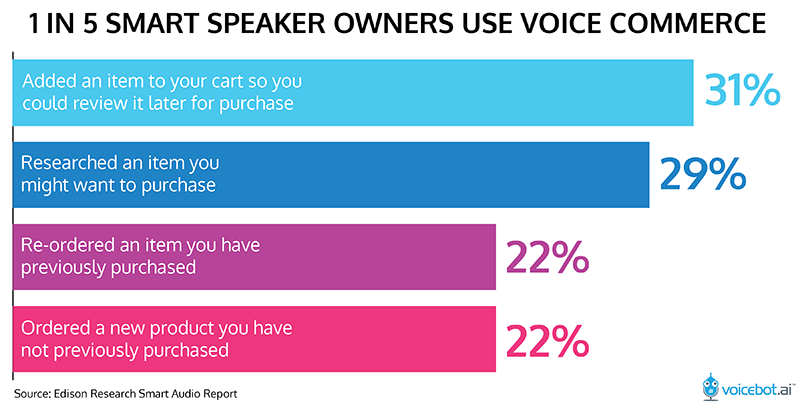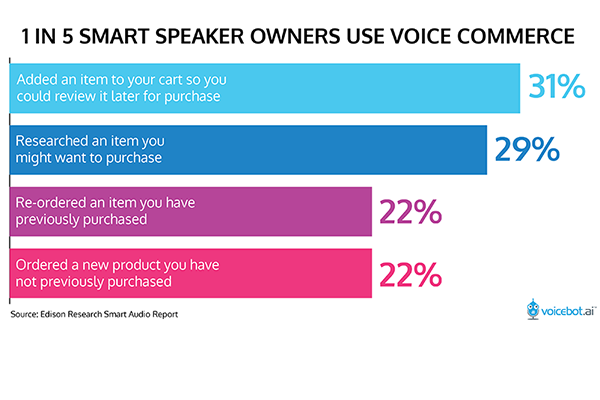Voice Commerce Tried by 22 Percent of Smart Speaker Owners
The Smart Audio Report released in January by Edison Research and NPR has a lot of interesting data on U.S. smart speaker owners. The voice commerce numbers might be the most intriguing results. The survey found that at least 22% of U.S. smart speaker owners have purchased something using the devices.

Voice Commerce is Bigger Than Expected
According to the survey, voice-based purchasing is evenly distributed between consumers that have re-ordered previously purchased items and those that have placed orders for new items not previously purchased. This is noteworthy for two reasons. First, the number of consumers that have made a purchase using a smart speaker must be higher than 22%. It could only be 22% if everyone that had ordered something through smart speakers had both re-ordered an item and ordered a new item.
This makes Cap Gemini’s finding in a similar survey more easily understood. In that survey, 35% of respondents said they had bought a product using voice. However, two things were different in the methodology. The survey was conducted online only and it included purchases made by voice through other devices such as smartphones. If you adjust that number to 30-31% to better reflect the online representation of consumers, we are converging on a numbers that depict a similar voice commerce adoption rate.
Voice Commerce is Not Just About Reorders
Second, there has been widespread speculation that voice commerce through smart speakers would only be suitable for re-ordering products. The supposition is that consumers need to see a product before purchasing. This appears not to be the case. I personally ordered batteries through Alexa despite never having used the Amazon battery brand previously and Tobias Goebel ordered a smartphone charging cable in 22 seconds using voice. Neither purchase was strictly a re-order, but they did represent commodities familiar to both purchasers. You might need to know something about a product to order by voice, but it is not necessary to have ordered it previously.
Voice Commerce and the Path-to-Purchase
We also see in the data that consumers are using voice in the pre-purchase consideration phase of the buying process. Twenty-nine percent of smart speaker owners reported using smart speakers to research a product they were considering for purchase and 31% had added an item to a shopping cart for later purchase consideration. These are activities that the newly minted Alpine.AI calls the voice-enabled path-to-purchase. CEO Adam Marchick commented in a Voicebot interview about the rising importance of voice-first channels for retailers:
This appeals to retailers that derive revenue from eCommerce because they are seeing more and more of their searches come through voice…Should I buy an LG or Sony TV. I need information. I may not be ready to make a purchase, but [voice] is part of the path to purchase. Brands and retailers must be represented or be vulnerable and the time is now.
A lot of this consumer shopping data is no doubt driven by Amazon as it enabled voice purchasing through Alexa very early. However, Google is pushing the voice commerce angle as well with a link to Google Express and partnerships with retailers such as Walmart and Target. If you review the Edison and Cap Gemini data, it is hard to come away with any conclusion other than the fact that consumers are ready for voice commerce and already giving it a try.
You can access the Smart Audio Report here.
When Voice Meets Impulse Buy: From Thought to Transaction in 22.6 seconds









